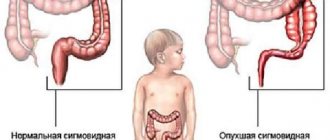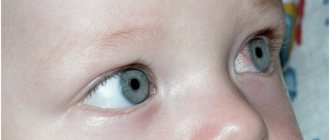Society accepts children’s whims quite tolerantly - he’s small, and when he grows up, he’ll understand! There is some wisdom in this, since the nervous system of babies really undergoes significant changes in the first years of life; with whims, a baby can “signal” to others his fatigue, tension, dissatisfaction, disagreement with something, his poor physical condition if he is sick.
However, an overly capricious child can undermine the nervous system not only of parents and others, but also of himself.
The famous children's doctor Evgeny Komarovsky tells what to do if a child is capricious, and whether it is possible to correct his behavior.
Nervous child symptoms
How diverse are the types of nervous disorders in children and the causes that cause them, so wide is the range of symptoms of childhood nervousness. · Increased mental fatigue (asthenia); · Distractibility and difficulty concentrating; · Inability to restrain emotions and their exhaustion for a short time; · Presence of various fears (phobias); · Anxiety and lack of self-confidence; · Obsessive states – fears, thoughts and actions that occur in addition to desire, combined with suspiciousness; · Mood swings, moodiness, manifestations of selfishness; · Psychomotor disorders – excessive mobility, enuresis (urinary incontinence), stuttering.
Each type of child’s nervousness is based on an unresolved internal conflict: a conflict between desires and capabilities, a conflict of self-affirmation, a conflict of recognition. For example, a boy really wants to be like his father, but at the same time he is very attached to his mother, with whom the father is extremely rude. A child cannot lose a role model or ignore the abusive actions of his father. An overload of the psyche occurs, leading to a nervous breakdown, expressed in the need to constantly wash your hands, as if washing away bad thoughts.
Children actually experience neurotic pain For example, abdominal cramps make it possible not to go to school or kindergarten, and distract the mother’s attention from the newborn to the older child. Plucking eyebrows, hair, biting nails and lips can also be a manifestation of nervousness that disappears after the traumatic situation is resolved.
When to see a doctor
Most often, parents take their capricious, disobedient and hysterical child to see a pediatrician with this problem at the age of 4. Until this age, they justify children’s “concerts” by early age-related crises, individual behavioral characteristics, the child’s temperament and other reasons. However, according to Komarovsky, at the age of 4-5 it is already quite difficult to solve a neglected pedagogical problem, which undoubtedly exists.
Parents should be wary of certain features of the child’s behavior during the active phase of hysteria.
If the baby makes a “hysterical bridge”, in which he arches his back and extremely tenses all his muscles, if he experiences holding his breath with loss of consciousness, for her own reassurance it is better for the mother to show the child to a pediatric neurologist and visit a child psychologist.
In general, the physical manifestations of hysteria in a child can be different, including convulsions, clouding of consciousness, and short-term impairment of speech functions. In some cases, such reactions may indicate not only the child’s sensitivity and temperament, but also certain diseases of a neurological and psychiatric nature. If in doubt, go to a specialist doctor. If nothing else happens except holding your breath while yelling, Komarovsky advises to deal with it simply - you should blow in the face of the hysterical person, he will reflexively stop yelling and take a deep breath, breathing will return to normal.
We also recommend reading the article with Dr. Komarovsky’s recommendations for hysterics in a child.
Nervous tics in children
Tics are involuntary twitching of the facial muscles. Children may wink, wrinkle their forehead, sniffle, cough, twitch their lips and chin. Adults may perceive these manifestations as pampering, make comments, and establish prohibitions. After such a short delay in the manifestation of the tic, it resumes with a vengeance. The tic is accompanied by headache, aggressiveness and irritability, as a way out of increased nervous tension as a result of the ban.
Factors that increase tics: · Physical and mental fatigue; · Heat, stuffiness, changes in atmospheric pressure; · Bright light, strong sound, flickering pictures when watching TV shows, from a computer screen; · Unusual situation, excitement, fear; · Excitement in disinhibited and hyperactive children.
Tics are a kind of outlet for accumulated internal tension. A very nervous child with similar manifestations has vulnerability and increased emotional sensitivity. These children are very impressionable, have an increased sense of self-esteem, and are sensitive to the assessment of others. Most often, they are choleric in temperament, cannot sit still, are impulsive and impatient.
Directly treating tics is very difficult. It is necessary to determine the cause of nervousness and begin treatment from it. And at home, we can advise parents to give their children the opportunity to relax more often - playing with a ball, running, jumping, climbing, and outdoor games will improve the child’s health and relieve excessive excitement. It is also necessary to adjust child-parent relationships, reduce conflict, and not perceive tics as manifestations of stubbornness and self-indulgence.
Treatment of nervous children
Treatment of pathologies of the nervous system is not a quick or simple process. With the question “What should I do with a nervous child?” It is better to contact a pediatric neurologist. The most common reasons for visiting this doctor are childhood fears and sleep disorders. A nervous child of 2 years old suffers most from separation from significant people, excessive strictness of parents, lack of love and neglect of the child. Fear of separation is especially acute when adapting to kindergarten.
A nervous child at 3 years old is most afraid of closed spaces and darkness, which has a negative effect on falling asleep. It is at this age that he may experience fear of fairy-tale monsters that come in his dreams. Adults should not abuse intense prohibitions, which will lead to the closure of the psychological space around the child and the emergence of a feeling of fear.
Excessive viewing of TV shows, passion for computer games, and the presence of children during parental conflicts are very harmful to a child’s psyche. A calm, friendly atmosphere, walks in nature, playing together, reading, drawing, listening to the best examples of music that a child can understand will do much more to correct children’s nervousness than taking medications.
You can invite older preschoolers to draw their fears. This reduces mental stress from waiting to meet your fear. It is worth helping a child start drawing, but he must do the bulk of the work himself; depicting death is taboo; abstract categories are inaccessible to children. The drawing should be discussed with the child and praised for overcoming the fear of facing fear.
What is nervous behavior?
Nervousness manifests itself in different ways. Naturally, moodiness is a completely natural thing for children. Until the age of 3, while the basic mechanisms of personality are being formed, it is difficult for them to express their emotions, experiences, fears and desires. In this regard, you may notice increased excitability. It becomes pathological when:
- The baby's interest quickly switches, attention is scattered and he cannot do one thing for a long time. One of the reasons for this behavior is attention deficit disorder. At the same time, he is impulsive and hyperactive.
- Speech becomes excessively fast and unintelligible. He may often interrupt his interlocutor, express emotions too vividly, not noticing anything around him and not controlling himself.
- With increased nervousness, health suffers. This can manifest itself in insomnia or increased sleepiness, nervous tics, loss of appetite, urinary incontinence, weak immunity and other unpleasant consequences.
- Frequent changes in intensity, giving way to fatigue and aggression and vice versa. Before going to bed, the baby may be excessively capricious and tearful. Increased emotional response to what is happening.
- Suspiciousness and self-doubt.
The main thing is to notice such symptoms in time and be prepared for the fact that you will have to change not only the life of a young family member, but also your own.
Child development at 2-3 years old: what to do if the baby is nervous and disobedient
Later, you can repeat the drawing, inviting the child to portray himself as not afraid. The image of fear can be torn up and thrown away.
Teaching a child how to behave appropriately in various life situations can be done with the help of finger theater puppets. Play therapy and art therapy produce miracles. By acting out scenes and dialogues, you can create complex psychological situations and push the child to resolve the conflict. Let him teach the fairy tale hero how to behave, defend himself, and communicate adequately.
A nervous child, with the sensitive, attentive attitude of people close to him and the optimal method of treatment and rehabilitation, is able to overcome his problems and regain stable mental balance.
Fear and anxiety in children
Stuttering in children - causes and treatment
Insomnia in children. The child does not sleep well
Neurosis in children. Hysterics.
Asthenic childhood neurosis
Everything infuriates and irritates - many people fall into this state, not realizing the reasons for their own uncontrollable anger. Literally everything can be annoying, and it’s not at all clear how to get rid of anger and find peace.
Aggression, anger and hatred surround many of us.
A 2-year-old child is constantly capricious and often freaks out: what to do?
In modern society, increased irritability is considered to be the norm in the rhythm of our lives, in the age of technology and information. But the reasons for your anger should not be explained only by the circumstances of your life. As you know, we ourselves are the creators of our own happiness and our own misfortunes too. Therefore, if the situation “I am constantly angry” describes your emotional state, then you should definitely understand its reasons.
If a person is irritated by literally everything and everyone around him: people, society, specific close relatives, the state, husband/wife, his own and other people’s children, the weather, someone’s behavior, etc. - of course, the point here is not only in the personal characteristics of the person himself or only in the surrounding external factors. Irritation, hatred and anger arise not simply because someone does not live up to your expectations, behaves in a particularly “wrong” way, which causes your irritation, does not correspond to your ideals, ideas about what is beautiful, true and right.
An interesting fact has long been noticed: in people we are often irritated by precisely those traits, properties and characteristics that we have in ourselves. It would seem that this is stupidity - since I am constantly angry, hate society, certain or all people in a row - it is only because I know how to live and behave correctly, and everyone around me denies my ideals and principles! But nevertheless, the fact remains - if you hate something, despise something, or feel irritated with someone, then you need to first of all deal with the internal subconscious reasons that force you to experience such negative emotions.
Causes of personal aggression and anger
If you are interested in why something or someone irritates you: the people around you, their behavior, or any environmental factors, you should admit that it is in you. Are you annoyed by someone's manner of speaking, dressing, life position, success, status? Observe yourself and how these traits manifest themselves in you. How much do you allow yourself to behave this way?
Moreover, you can either deny the traits and factors that irritate you in yourself, scold yourself for their presence, or simply not notice that you sometimes behave in exactly the same way. Why do people annoy you? Partly because you turn them primarily on your own shortcomings, as if you are angry at your reflection in the mirror. Even if you diligently deny it and consider yourself “better” and “more correct” than the one on whom you take out your anger and irritation.
In addition to the fact that you may deny something about yourself that causes you irritation, such negative emotions can arise if
- you want to have something, but for some reason you don’t allow it (due to your limiting beliefs and attitudes); you are subconsciously attracted to what others have; and the dissonance “I want-I have” provokes aggression, envy: they could do it, but I couldn’t;
- in others, you may be irritated by your own shortcomings, which you are especially careful to combat;
- a huge number of your ideas about what is right and wrong, good and bad, worthy or despicable - force you to pay attention to the bad and get angry from the presence in your own environment, in your opinion, of everything “imperfect” and “wrong”.
What to do if everything annoys you
In any case, if you are annoyed by people, their character traits, achievements, or even their appearance, you should not rush to shift the blame onto them for changing your own mood. The outer world is a reflection of the inner world, beliefs, beliefs of a person. Your anger, hatred and resentment do not arise out of nowhere and other people are in no way the cause of it. The reason is hidden within a person.
There is a common expression that perfectly describes this situation: “he sees a straw in someone else’s eye, but does not notice a log in his own.” It couldn’t be more accurately said about people who are always irritated, grumpy and indignant at everyone and everything, who are constantly infuriated and irritated by everything. Their anger is directed at others, when they should think about their own views on life and change something in them.
Often, someone who condemns rich people and becomes furious when talking about how “everyone steals from us” most likely secretly dreams of becoming such a person and will accumulate wealth in exactly the same way if he is given such an opportunity. Some people are annoyed by bosses, barefoot people, and almost everyone dreams of becoming a boss and it is not known how he would behave in a higher position. Often people are annoyed by extraordinary and unusual people, perhaps because we are all used to keeping ourselves within the rules and do not dare to go beyond them, but for some it is as easy as breathing.
How to find peace
To cope with aggression and get rid of your own anger, you need to recognize that you yourself are its inexhaustible source. You are responsible for the occurrence of such negative emotions. The more you deny something in yourself, suppress emotions, try to comply with external rules while internally protesting, the more the outside world will show you what you don’t like. Fighting, resisting, hating and getting angry even more is not a solution, but a dead end that will only make the situation worse and can negatively affect your health. After all, aggression, anger and hatred are very strong negative emotions that accumulate in your body and poison it.
The normal state for an internally free person is an even perception of the surrounding reality without outbursts of negativity and anger. When a person decides to deal with his own limiting beliefs and release the aggression seething inside him, he first of all learns a lot about himself and stops blaming other people and external circumstances for his own troubles. Even if a person discovers something that caused irritation in himself, he gradually learns to accept himself, and then the people around him, calmly and evenly, without outbursts of anger. reconsiders his views, his once unbreakable convictions.
Calmness and harmony come from within, as does freedom, which no external benefits can give until a person has established his own inner world, dealt with his negative views on life, and learned to always take full responsibility for his own life, without discounts. to circumstances and other reasons and excuses. The Turbo Gopher system can be useful for those who have decided to take just such an important step in their lives, to learn how to find peace and get rid of aggression. A book describing the system will provide more detail on what to expect and what not to expect during development. download it from this site.
We also recommend that you read: Psychosomatics of digestive problems
Home>>Children and family>>Preschoolers>>Hysterics in children 1-3 years old
Your baby screams all the time, but there is an easy way to deal with it.
Author:
therapist Sergey Ponkratov
6 minutes
2537
“When will you stop crying? How can I help you? - questions that tired parents often ask in the first year of their beloved child’s life. “He just has colic!” an experienced grandmother will say, and, more often than not, she will be right. But this doesn’t make it any easier: what to do with these colics? Fortunately, today science has solved this problem. True, a little later than I figured out the flight to the Moon.
Find the cause, prescribe treatment
To get first-hand information about what causes these symptoms of anxiety and how modern medicine can help babies and parents sleep peacefully at night, we turned to Galina Asmolova , Candidate of Medical Sciences, Associate Professor of the Department of Neonatology at the Federal Faculty of Postgraduate Education. For 20 years she has been engaged in dynamic observation and rehabilitation of young children at the Children's Hospital named after. N. F. Filatova. Here's what the doctor said:
Experts have proven that almost half of the cases of abdominal pain, regurgitation, flatulence, and constipation in the first year of life are associated with impaired enzymatic activity in the intestines and/or intolerance to certain foods . First of all, cow's milk protein. On their own, without appropriate nutritional correction and treatment, such disorders do not go away. Otherwise, they inevitably aggravate problems of digestion, intestinal microbiocenosis, lead to damage to the intestinal barrier and form food intolerance.
Why does a baby have a stomach ache?
When abdominal pain is diagnosed in a child under 6 months, the main question is “ Is the pain related to feeding?”
If abdominal pain begins suddenly, and after several hours passes or decreases by stroking the tummy clockwise/applying a warm diaper, this is our “favorite” infant colic.
But the mechanisms of development of colic are different. We cannot call the pain that occurs with every meal a true colic.
If every time after feeding a child screams in pain, spits up, suffers until the next feeding, trying to digest what he has eaten, you should think about the presence of problems with digestion, first of all, of the milk sugar lactose - lactase deficiency and / or intolerance to some food component, most often - cow's milk protein.
Symptoms that make you think about lactase deficiency:
- increased gas formation
- bloating
- abdominal pain during and after feeding
- "shooting" loose, watery stools with a sour odor
The result of a stool test for carbohydrates can confirm our fears
What to do in this case?
- Review your diet. If the child is breastfed, then it is necessary to change the mother’s diet: exclude milk from the diet and minimize the consumption of fermented milk products, especially kefir, yogurt, curdled milk, and fermented baked milk. Heat-treated cottage cheese, cheese, and butter can be left in limited quantities (unless the child has intolerance to cow's milk protein).
- The doctor will help you select and prescribe a drug for your child to eliminate the symptoms of increased gas formation. Such drugs are of synthetic and natural origin. For example, herbal drops Kolik Kalm , which have an antispasmodic effect, increase intestinal motility, improve the passage of gases, and reduce heartburn and pain.
- Replacement therapy with the enzyme lactase may also be required. This enzyme can be in the form of a dry powder in capsules (Lactase baby, Lactazar for children) or in drops, for example, Colif . In Russia, the drug Colief® Infant Drops was registered quite recently. Although the drug itself has been successfully used in Europe and America for more than 15 years. Colif is created on the basis of natural ingredients, so it does not cause side effects or allergic reactions. The drops are convenient to dose. Produced by an Irish company according to the international GMP quality standard, its effectiveness and safety are confirmed by clinical studies in Europe. It was also noted that improvement in symptoms was observed after just two days of taking the drug.
It is worth noting that when taking enzymes in the form of drugs, children’s own fermentation is not disturbed in any way. The drugs perform only a replacement function. Based on the clinical picture and the nature of the stool, the doctor always understands when it is necessary to reduce the dosage or stop using it.
Intestinal microflora and lactase deficiency
In children suffering from colic, the content of E. coli and Klebsiella in the intestinal microflora increases, and the number of lactobacilli decreases. The colonization of the child's intestines with microflora occurs in stages. The baby acquires some of the microflora while passing through the mother’s birth canal, and some with the first drops of colostrum. After birth, breast milk becomes the main source of lactobacilli necessary for the baby. But the level of lactobacilli in the intestines is often insufficient, and in such cases additional intake of probiotics is required.
What drugs can a doctor prescribe to improve microflora? Probiotics are drugs that improve intestinal microflora and contain the “right” bacteria in dry or liquid form.
There are special requirements for bacterial strains used in infant therapy. They must be safe and grown under certain conditions. In addition to Lactobacterin, which has long been known in Russia, a new Canadian drug BioAmicus Reuteri . Each dose contains 200 million naturally occurring human Lactobacillus L. Reuteri isolated from breast milk. Thus, BioAmicus Reuteri has no analogues in Russia. Moreover, the safety and effectiveness of these lactobacilli has been proven in clinical studies. The drug itself is produced in the form of drops according to international GMP standards, it is more convenient to dose and it acts faster.
We would like to thank the Novonatum , which is the exclusive distributor of high-quality natural medications for children in Russia and the CIS countries, for their assistance in creating the material.
Important questions about feeding, bowel movements and abdominal pain
Could abdominal pain in a child be a sign of a dangerous disease requiring surgery?
Pathologies of the gastrointestinal tract requiring surgical intervention are possible in children, but, as a rule, this happens not in infants, but in older children, at the age of introducing complementary foods, when liquid food is replaced by thick food. If a child behaves unusually, cries for a long time and does not calm down, it is better to consult a surgeon to exclude the possibility of surgical pathology.
How many times a day should a baby under 6 months have stool?
The frequency of stool depends on many reasons, primarily on the type of feeding. If a child is breastfed, and his stomach does not hurt, he does not feel discomfort, he can poop once a day, or five, or even eight, and this is normal. Some breastfed children, without experiencing discomfort, poop once every five to seven days, and this is also a variant of the norm; if the baby is not in pain and is gaining weight, a doctor’s intervention is not required.
with artificial feeding . Children who, when bottle-fed, do not have stool once a day (or at least once every 48 hours) will always have something to worry about. With artificial feeding, it is normal for the baby to have stool once or twice a day.
By the age of introduction of complementary foods, the frequency of stool in all children, as a rule, varies from 1 to 4 times a day.
You need to pay attention to changes in stool frequency. If a child who pooped two or three times a day suddenly began to poop six or eight times, and at the same time the consistency of the stool changed, flatulence increased, and regurgitation appeared, this is a reason to worry, remember what has changed in his diet or the mother’s diet, and, Perhaps consult a doctor.
Should I give my baby water? How to do it?
A breastfed baby receives the necessary fluid through mother's milk. You can offer him water (from a spoon, a little at a time), but let the child decide for himself whether he will drink it. If a breastfed baby actively and greedily drinks water, it is necessary to monitor his weight. If your baby is not gaining well, it is worth considering whether he has enough milk, checking whether he is eating enough (this can be done by weighing the baby before and after feeding), and taking measures to stimulate lactation. If a child receives enough milk, but actively drinks water, then it is also advisable to find out the reason; perhaps he is hot and stuffy, or it is due to the foods that the mother eats.
When bottle-fed, it is very important to maintain a drinking regime; such a child must be given water, from a bottle or from a spoon - before each feeding, give at least 10-15 ml of water 20-30 minutes before.
Should I feed my baby at night?
In the first month of a baby's life, you need to feed at night. Firstly, it is useful for the development of lactation - prolactin, the hormone responsible for milk production, is produced more actively at night, and secondly, it rarely happens that a child of the first month of life does not ask for food at night from 12 to six in the morning, this happens in underweight children who do not have the strength to ask for food. If your baby sleeps through the night in the first month, check his weight gain.
The interval between feedings increases gradually. If the child is breastfed, the night intervals gradually begin to increase - from 2-3 to 4 hours, closer to 4 months - up to 5 hours.
Trying to solve all the problems that arise at night by breastfeeding seems to me personally a big mistake. As soon as we start doing this, the child develops a reflex: “As soon as I opened my mouth, they immediately gave me the breast.” The night reflex becomes stronger, and the child begins to eat first every two hours, then every hour and a half, and then every hour, and the older the child gets, the more often he eats. Although he does not eat, he simply suckles, thus reducing his anxiety. It is worth giving the baby the breast only when he is hungry, and if we know for sure that the child is not hungry, look for other ways to calm him down.
How to respond to children's hysterics?
Almost all children aged 1-3 years throw tantrums , and sometimes attacks of hysteria can be observed. If a child is beside himself with anger, then you can often see a picture of him throwing himself on the ground, screaming as hard as he can, beating his arms, legs or head on the floor. And it’s quite natural that parents don’t know how to react to their children’s hysterics .
If hysterics rarely occur in children, this does not explain anything. Because in any case, sometimes you have to limit the child in something, and this, in fact, can cause another outburst of rage in the child. If your child aged 1-3 years throws tantrums at you regularly, and even more so, many times a day, then this is a sign that he is somehow sick, perhaps with some kind of chronic disease. Or the baby is simply very overtired.
If a child throws tantrums very often, then we can say that the mother was unable to find a common language with the baby and did not understand the secret of communicating with him. Therefore, it is not always possible to prevent hysteria. And this is also understandable. After all, even the most imperturbable parents lack tact and patience. But you shouldn’t think that if children behave this way, then they have bad parents. Even in happy families, children can be out of sorts and angry about something.
If a tantrum does begin, then try to simply ignore it and, at the same time, help the baby cope with it. At the same time, you cannot follow the child’s lead, you should not give in to him. Indeed, in this case, if a child, having thrown a tantrum, achieves his goal, then in the future he will constantly arrange similar things in order to achieve his goal again. And in this case, it will be more difficult to cope with hysteria. Therefore, descent should not be given.
At such moments, you cannot argue with him, because he still will not hear your arguments and will not listen to what you try to explain to him, and, therefore, will not understand the most important thing - that he himself is wrong in this situation. Also, the parents themselves should not be angry.
Where do whims come from?
If a child often freaks out and is capricious, there may be several reasons for this:
- He feels unwell and is unwell.
- He gets overtired and experiences stress (especially if his whims recur in the evening).
- He is poorly brought up, he throws tantrums because he is used to getting what he wants this way.
Dr. Komarovsky believes that any excessive manifestation of capriciousness is aimed primarily at parents. If the baby has spectators who are affected by his hysterics, he will use this “weapon” every time he needs something or something stops suiting him .
The reasonable actions of parents in this case should be to ignore - a baby who has been denied the opportunity to get his hands into a hot oven or plunge a cat into the toilet can scream and be indignant as much as he wants, mom and dad must be adamant.
It is advisable that all family members, including grandparents, adhere to such tactics. Komarovsky emphasizes that children become tyrants and manipulators almost immediately after they realize that with the help of hysterics they can achieve what is forbidden to them.
Nervousness in a 2 year old child
After all, if you get angry yourself, the child may become even more angry and the hysteria may drag on for a long time. You just need to give the child the opportunity to capitulate with dignity. Many children can calm down much faster if left alone. The baby can immediately switch to some toy and begin to mind his own business.
Of course, there are more stubborn children. Some of them are capable of screaming and screaming for more than an hour until their mother comes to meet him. A woman, for example, can caress him or interest him in something. Thus, she shows her willingness to make peace at a time when the worst part of the hysteria has already passed.
If a child throws a tantrum right on the street where there are a lot of people, then such moments are very unpleasant. Surely, many parents have found themselves in such situations and experienced a huge sense of shame and awkwardness. How to react to a child’s hysterics in this case? You can take the child in your arms and smile, even through force, and take him to a quieter and more peaceful place, where there are few passers-by. There you can both cool down and come to your senses a little.
In moments of hysteria, a child may even experience attacks of suffocation, and he may lose consciousness for a short time. And these states are nothing more than an expression of his anger and stubbornness. Of course, such seizures can frighten the mother, but, nevertheless, one must learn to perceive them calmly, so that they do not become the causes of conflicts in the family between mother and child, and so that the child, thus, cannot influence and manipulate the parents.
We also recommend looking at the articles:
Search Lectures
Read the text, complete tasks 1 -3
Option 3-17
Part 1
(1) During experiments, neuroscientists were able to find out that during sleep, new interneuron contacts are formed in nerve cells, necessary for storing information. (2) This explains the long-known fact that memory consolidation - the transformation of short-term memory into long-term memory - occurs most actively in sleep, when our nervous system is engaged in sorting the information received during the day, while external signals do not interfere. (3) in order to remember the textbook you read before the exam, you need to sleep, then the information, as they say, will settle in your head, that is, it will go into long-term storage.
1. Indicate two sentences that correctly convey the information contained in the text. Write down the numbers of these sentences.
1. To better prepare for exams, you need to sleep more, rather than sort through the information received during the school year.
2. During experiments, neuroscientists were able to find out that memory consolidation - the transformation of short-term memory into long-term memory - occurs most actively during sleep.
3. Memory consolidation occurs most actively during sleep, when new interneuron contacts are formed in nerve cells, necessary for storing information.
4. Sleep is just another form of brain activity, and at night our nervous system works much more and more efficiently, because external signals do not prevent it from sorting the information received during the day.
5. During sleep, when new interneuron connections are formed in nerve cells, the transformation of short-term memory into long-term memory occurs most actively, which contributes to the memorization of information.
2. Which of the following words (combinations of words) should appear in the gap in the third (3) sentence of the text? Write down this word (combination of words).
However, because
Contrary to this, the fact is that
That's why
3. Read a fragment of a dictionary entry that gives the meaning of the word CONTACT. Determine the meaning in which this word is used in the first (1) sentence of the text. Write down the number corresponding to this value in the given fragment of the dictionary entry.
CONTACT, -a, m.
1. Contact, connection (special). Electric k. Tectonic k.
(in the earth's crust).
2. Business communication, consistency in actions.
Trade and economic contacts. Log in to a room with someone. Act in contact with someone.
3. Direct communication. K. with the patient.
4. Part that ensures contact between the wires of the electrical circuit (special). Solder to.
4. In one of the words below, an error was made in the placement of stress: the letter denoting the stressed vowel sound was highlighted incorrectly. Write this word down.
accountants fructose will borrow it torn and locked
5. In one of the sentences below, the highlighted word is used INCORRECTLY. Correct the lexical error by choosing a paronym for the highlighted word. Write down the chosen word.
The DIPLOMATIC meeting was attended by politicians from friendly countries.
The biologically active substances contained in celery have a BENEFICIAL effect on the metabolism in the body.
Striving for an objective assessment of what was happening, the teacher tried not to express his PERSONAL opinion.
The actress who received the award proved that it is not necessary to have an EFFECTIVE appearance.
The main thing is not to make a mistake when CHOOSING your path in life.
6. In one of the words highlighted below, an error was made in the formation of the word form. Correct the mistake and write the word correctly.
kilogram of APPLES
GO FORWARD
company of SOLDIERS
in two thousand and eleven
TWO HUNDRED copies
7. Establish a correspondence between grammatical errors and the sentences in which they were made: for each position in the first column, select the corresponding position from the second column.
Write down the selected numbers in the table under the corresponding letters.
| GRAMMATICAL ERRORS | OFFERS |
| 1. violation in the construction of sentences with participial phrases | 1) At the end of the performance at the Sovremennik theater, the applause did not stop for a long time. |
| B) an error in the construction of a complex sentence | 2) This year MSU held several Olympiads for schoolchildren. |
| 1. violation in the construction of a sentence with an inconsistent application | 3) Activists of social movements forgot about differences and acted as a united front against the closure of the museum. |
| D) disruption of the connection between subject and predicate | 4) White water lily rhizome is a product from which flour can be obtained. |
| D) an error in constructing a sentence with homogeneous members of the sentence | 5) Chekhov's intellectual was a man who combined decency with the inability to implement his ideals. |
| 6) Having paid the invoice, you must inform the publisher in writing of the payment order number. | |
| 7) This book taught me to value friends, which I read as a child. | |
 In the plot of Fathers and Sons, ideological disputes between representatives of different social forces occupy an important place. In the plot of Fathers and Sons, ideological disputes between representatives of different social forces occupy an important place. | |
| 9) Finding themselves on a drifting ice floe, the fishermen hoped and believed in salvation. |
8. Identify the word in which the unstressed unchecked vowel of the root is missing. Write out this word by inserting the missing letter.
Intellectual..comfort..comfort
H...loving, deceitful...
Co-ordination
9. Identify the row in which the same letter is missing in both words. Write out these words by inserting the missing letter.
too...extremely, seamlessly
pr..tear, pr..crowded
p..got, p..played
d..added, pr...grandfather
r...yany, approaching...
10. Write down the word in which the letter I is written in place of the gap.
overcome... enterprising...
ice..thread (soul) cherry..vy
coughed..coughed
11. Write down the word in which the letter Y is written in place of the gap.
quarreling (guys) (the bees hurt) sting..t
under construction (new houses) creeping (fog)
adhesive (pencil)
12. Determine the sentence in which NOT is written together with the word.
Whims in infants
In infants, whims, as a rule, have good reasons. The baby does not take the breast, is nervous and cries in the first months of his independent life not from harm, but from unmet needs or physical discomfort.
To begin with, Komarovsky advises making sure that the child has the right conditions for healthy growth - his room is not hot or stuffy.
The optimal recommended parameters are: air humidity 50-70%, air temperature - 18-20 degrees. It is imperative to analyze the baby’s daily routine - how much he sleeps, how much he walks, how much he stays awake.
Often, a baby can be capricious from lack of sleep or vice versa - from excess sleep, from overeating, if parents forcefully feed the baby not when he asks to eat, but when, in their opinion, it is time for dinner. Overeating increases the frequency and intensity of intestinal colic, which causes a lot of unpleasant physical sensations. As a result, the baby becomes capricious.
Quite often, whims accompany the period of teething , but such attacks of crying and whining are temporary, as soon as the child’s condition returns to normal, everything will change, including behavior.
“Execution cannot be pardoned,” or what to do if the child is nervous and disobedient
Open the brackets and write down this word.
Korolenko writes about people who (NOT) SUBMIT to fate, full of desire for truth and freedom.
He rode, as it seemed to him, everything straight, SEEING nothing in front of him except the horse’s head.
But by nature, the father of the future writer was far from an EVIL man.
This (UN)FINISHED painting marked Vrubel’s return to a topic that had worried him all his life.
Yu. B. Levitan's voice was not at all similar to the voices of all the other announcers.
13. Determine the sentence in which both highlighted words are written CONTINUOUSLY. Open the brackets and write down these two words.
Leaving the house, we (IN) FIRST follow a country road, and (THIN) along an asphalt highway.
While the road ran near the swamps, (IN) VIEW of the pine forest, we (F) OFTEN scared away entire broods of ducks that had taken refuge here.
(ALL THE WAY) we made long stops near the water, (NOT) DESPITE the enormous loss of time.
The side, apparently, was deserted: forests were visible everywhere, but there were still no fields or villages.
In vain we peered (IN) THE DISTANCE of the horizon: (TO) MEET us a fog rose.
14. Indicate the number(s) in whose place(s) NN is written.
The spacious terrace of the dacha was very brightly lit by a lamp and four old candelabra placed on a long tea table.
15. Place punctuation marks. List two sentences that require ONE comma. Write down the numbers of these sentences.
1. The forest has fallen silent and in the glow of a blazing fire it seems magically ghostly.
2. A.S. Pushkin was not afraid of colloquial words and expressions and boldly introduced them into poetry.
3. Each time needs its own chronicler, not only in the field of historical events but also in the field of life and way of life.
4. The work calmed him down, cleared his head, and two hours passed unnoticed while he worked.
5. In our poetry there is reflection and sadness and the bitterness of separation and the sadness of unrealized meetings.
16. Place all punctuation marks: indicate the number(s) in whose place(s) there should be a comma(s) in the sentence.
In 1878 (1) the painting “Moscow Courtyard” shown at the VI traveling exhibition (2) brought V. D. Polenov fame (3) revealing the birth of a new genre in Russian painting (4) called “lyrical” landscape.
17. Place all punctuation marks: indicate the number(s), in the place of which(s) there should be a comma(s).
The name “Kolomna” (1), according to some researchers (2), goes back to the Finnish word. Before the arrival of the Slavs, Finnish tribes lived in this territory, they (3) probably (4) left this name.
18. Place all punctuation marks: indicate the number(s) in whose place(s) there should be a comma(s) in the sentence.
The provincial museum (1), the exhibition (2) of which (3) can be called a monument to the artist (4), has one of the most significant collections of works by the famous landscape painter.
19. Place all punctuation marks: indicate all the numbers that should be replaced by commas in the sentence.
Daria Alexandrovna tried to play (1) but for a long time she could not understand the game (2) and (3) when she understood (4) she was so tired (5) that she sat down with Princess Varvara and just looked at the players.
©2015-2018 poisk-ru.ru All rights belong to their authors. This site does not claim authorship, but provides free use. Copyright Infringement and Personal Data Violation
At an early age, children sometimes tend to throw tantrums. During such fits of rage, the child screams, cries, falls to the floor, stamps his feet, and bites. This behavior can be typical even for very calm children. Usually it occurs in response to some kind of parental prohibition.
Tantrums do not appear suddenly in a baby. The child gradually learns this technique of controlling parents. It is possible to fight childhood tantrums, but it takes some effort. To succeed in this matter, you need to remember why children throw tantrums.
Why do children throw tantrums?
Kids throw tantrums not because they like to misbehave, and not because they want to annoy their parents. Children scream, stomp their feet and throw themselves on the floor because it works . Being capricious, the child tries to get his way and, having received what he wants through hysterics, he will definitely use this method again. Therefore, how often he will resort to this method depends on the reaction of his parents.
How to deal with children's tantrums?
It is very important to learn how to extinguish and stop tantrums, otherwise it will become a baby’s habit, and he will begin to use them as manipulation constantly. So how can parents prevent tantrums?
Try to anticipate your child's whims to prevent them.
The most common mistake is to wait until his behavior gets completely out of control. It is necessary to learn to predict the child's condition before an outbreak occurs. Pay attention to the telltale signs of a storm - whining, restlessness, tension - and try to distract him at the first sign of irritation.
The kids themselves do not yet know how to control their emotions, so parents must help them. Try talking to your child in a soothing tone, pet him, hug him, sing a song.
Express zero tolerance for tantrums.
The child must understand that no one will tolerate his behavior.
CHILD IS VERY NERVOUS!!!!!
As soon as the hysteria begins, stop communicating with him until he calms down. Don't coax him, shout, spank him - none of these usually work. He won't even hear you over his screams. Try not to answer him, it’s better not to even look in his direction, you can demonstratively put on headphones - this will make it clear to the baby that his screams are useless.
Deprive your baby of spectators.
For recurring tantrums, it is best to isolate the child as soon as the outbreak occurs. If this happens in a public place, move him to a more private place until he calms down. Take him somewhere where there are no toys, TV, or other children. The child must realize that his behavior does not deserve games and attention.
The length of time he spends in the calming place may vary for different children, but he should remain there for at least two minutes from the moment he calms down. If he starts acting up again, take him back. The most difficult thing here is to maintain your own calm, but it will help the child return to a calm state.
Do not use solitude as punishment - you should not lock your child alone in a dark room, as he may develop childhood fears.
Your rejection of tantrums must be constant.
It is very important to choose a line of behavior during hysterics and always stick to it. Then the child will understand that the result of his whims is unchanged. If a child is capricious with other people - the nanny, teachers, your parents, discuss with them in advance a plan of behavior in such situations, emphasize that adults should not pay attention to whims. Communication with other children should be allowed only in a normal state. Talk to those who work with your child, this will help you evaluate your progress in re-education.
Reasons for changes in behavior due to physical needs
It is very important to create all the necessary conditions for the full development of the baby and his comfortable life, surrounded by warmth and care. Children aged one year are most likely to experience inconveniences of a domestic nature, due to which their disposition may change.
Anxiety disorders occur if:
- The daily routine is not followed.
- He is not provided with long sleep in a calm, quiet environment;
- The food he receives is inadequate. A lack of vitamins and macroelements greatly affects the nervous system and, as a result, the baby’s personality.
- Physical activity is insufficient or excessive;
- Hygiene rules are not followed.
Thus, poor nutrition and lack of attention can serve as a trigger for aggressive actions, nervousness and other psycho-emotional problems that lead to health problems.
But sometimes, the root causes may not depend on environmental factors or the will of adults and cannot be resolved by changing the daily routine. Here are some of them:
- Genetic predisposition;
- Previous infectious diseases;
- Brain injuries;
- Congenital disorders of the nervous system, etc.
These causes are more serious and can only be treated under the supervision of a specialized doctor or psychologist.
Fortunately, parents most often encounter gaps in the upbringing and relationship with their toddler. Then the baby’s nature can be adjusted through your own efforts.










